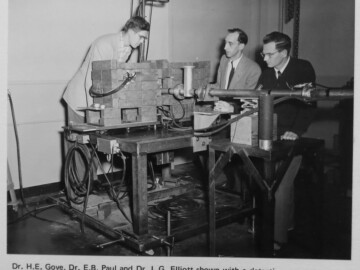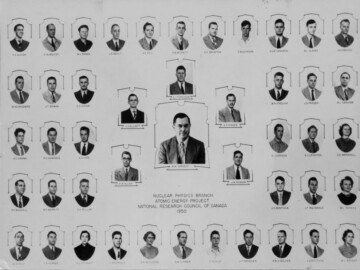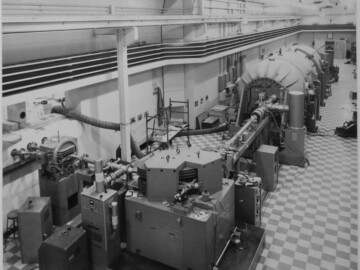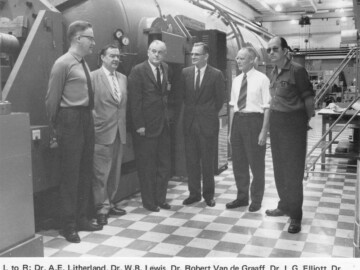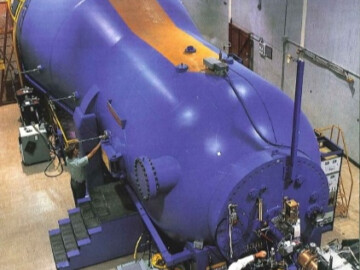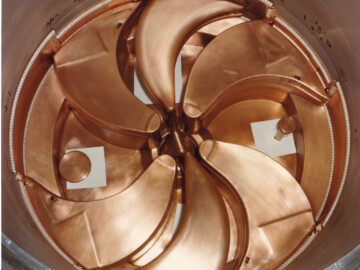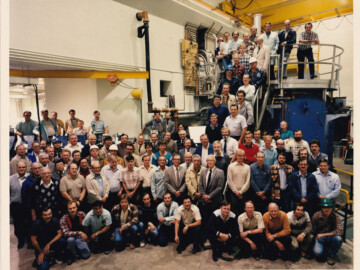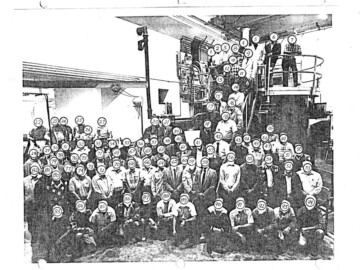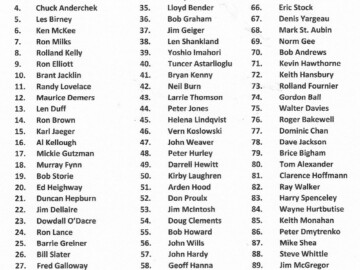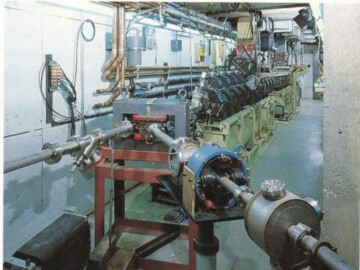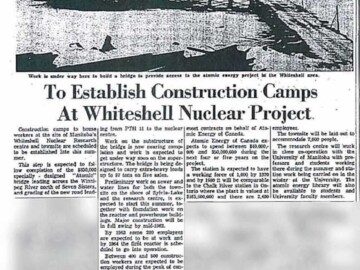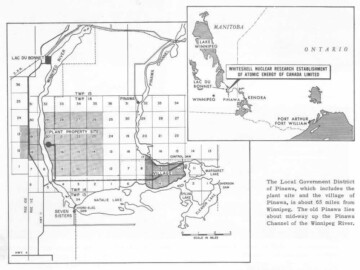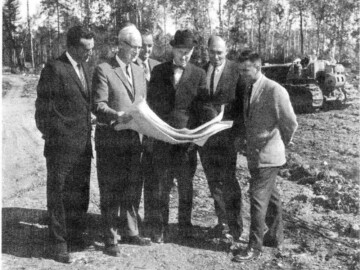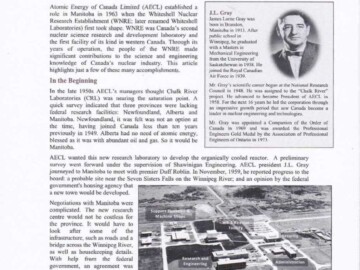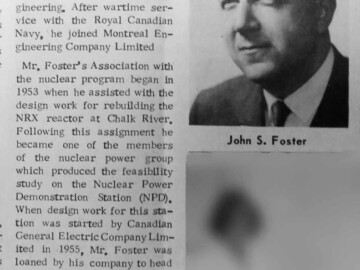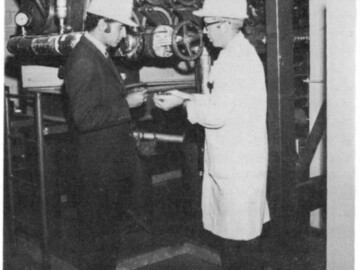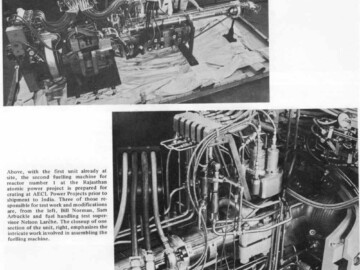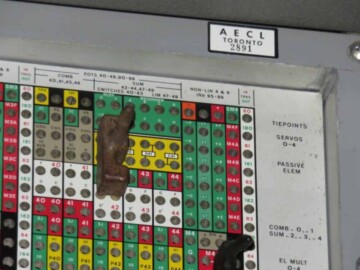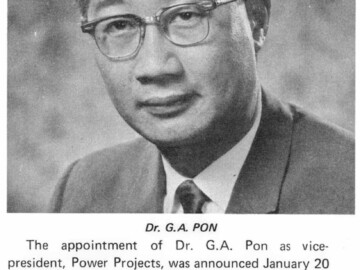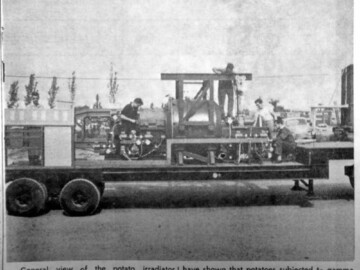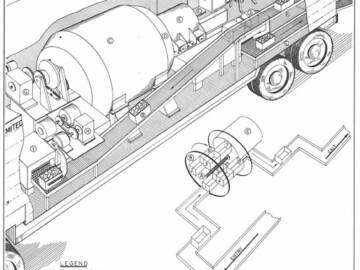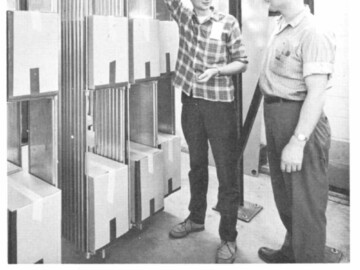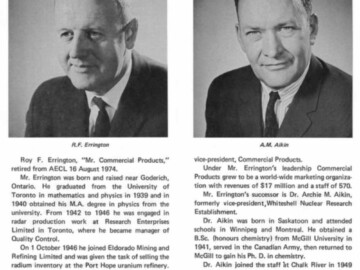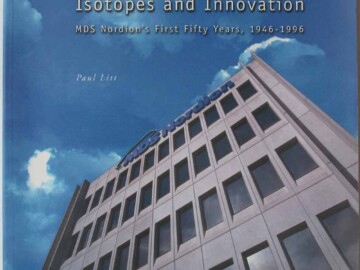AECL Activities
Accelerators, reactors and other projects
Accelerators
Particle accelerators played a big role in the nuclear physics studies undertaken at Chalk River. These began with a 240 kV unit and then advanced with the world’s first tandem accelerators and culminated with the Tandem And SuperConducting Cyclotron (TASCC). Nuclear physics research ended in 1997.
Related Papers
Hoffman et al. “Status of the Chalk River Heavy-Ion Cyclotron”, IEEE Trans. on Nuc. Sci., Vol NS-22, No 3, 1975, pg. 1647
https://accelconf.web.cern.ch/c81/papers/ci-02.pdf
Schmeing et al. “12th International Conference on Cyclotrons and their Applications”, Berlin, 1989. https://accelconf.web.cern.ch/c89/




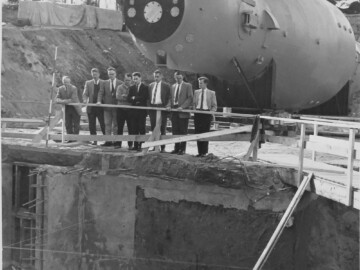

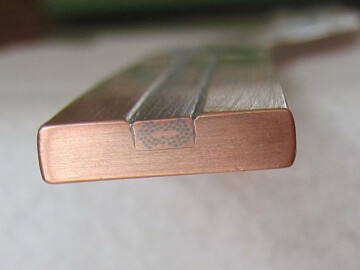

Applied Accelerators
The applied accelerators program began with the interest of W.B. Lewis to use high-energy protons to produce high fluxes of neutrons via the spallation program. Thes neutrons could be used for research applications or possibly for breeding reactor fuels. Spin-offs from this program included medical accelerators for treating cancers, small neutron sources and industrial irradiators. The program was shut down in 1996.
Related Papers
Bartholomew and P.R.Tunnicliffe “The AECL Study for an Intense Neutron Generator” AECL-2600 (1966) https://www.osti.gov/scitech/servlets/purl/4463128- 7d2Q76/
Chidley, S.B. Hodge, J.C. Brown, J.H. Ormrod and J. Ungrin “The Chalk River High Current Test Facility”, Paper presented at the 1972 Linear Accelerator Conference, Los Alamos.
http://inspirehep.net/record/80184/files/C721010-p218.PDF
Fraser, S.H. Kidner, J. McKeown and G.E. McMichael, “The Chalk River Electron Test Accelerator”, 1972 Linear Accelerator Conference, Los Alamos, 1972 http://inspirehep.net/record/80185/files/C721010-p226.PDF
Earle, A.B. McDonald, S.H. Kidner, E.T.H. Clifford, J.J. Hill, G.H. Keech, T.E. Chuff and M.R. Schneider. “Measurement of Parity Violation in the Photodisintegration of Deuterium and in the Production of Bremsstrahulung on Tantulum”, Can.J. Phys. 66(534), 1988.
http://www.nrcresearchpress.com/doi/pdfplus/10.1139/p88-089
Schriber L.W. Funk, S.B. Hodge and R.M. Hutcheon, “Experimental Measurements on a 25 MeV REFLEXATRON” IEEE Trans. Nuc. Sci NS-26, No 3, 1977, pg1061. https://accelconf.web.cern.ch/p77/PDF/PAC1977_1061.PDF
Levenson and C.S. Turner “An Investigation of the Therac-25 Accidents” Computer, July 1993. http://www.cs.umd.edu/class/spring2003/cmsc838p/Misc/therac.pdf
Fraser et al. “A Review of Prospects for an Accelerator Breeder”, AECL-7260 (1981)
https://www.ipen.br/biblioteca/rel/R44614.pdf
Schriber, “The ZEBRA Project – Past and Present”, Proceedings of the 1984 Linear Accelerator Conference, Seeheim, Germany, pg 501. https://accelconf.web.cern.ch/l84/papers/fre0006.pdf
McMichael, B.G. Chidley, R.M. Hutcheon and T. Tran Ngoc, “RFQI Fabrication and Low Power RF Testing”, 1987 Particle Accelerator Conference, http://epaper.kek.jp/p87/PDF/PAC1987_1875.PDF
Bolme et al., “High Power RF Operations Studies with the CRITS RFQ”, 1995 Particle Accelerator Conference. https://accelconf.web.cern.ch/p95/ARTICLES/WPA/WPA08.PDF
Bromley “A Review of AECL and International Work on Sub-Critical Blankets Driven by Accelerator-Based and Fusion Neutron Sources”, CNS 2013 Annual Conference, Toronto, ON.
https://www.cns-snc.ca/media/uploads/Bromley.pdf
Ungrin et al. “IMPELA: An Industrial Accelerator Family” European Particle Accelerator Conf. 1988. https://accelconf.web.cern.ch/e88/PDF/EPAC1988_1515.PDF
Ebrahim, “Lasers, Plasmas and Particle Accelerators – Novel Particle Accelerating Techniques in the 21th Century”, Physics in Canada 45 (6), 1989. https://forms.cap.ca/temp_PiC_archive/1989-v45-n6.pdf

The facility proposed would consist of a 1.6 km long linear accelerator that would accelerate a very intense (65 mA average) proton beam as well as a lower intensity, (1 mA) negatively-charged, hydrogen beam to an energy approaching 1000 MeV. The negatively-charged beam could be used for meson-physics experiments while the intense proton beam would be directed to a liquid lead/bismuth target where it would generate the intense neutron flux via the “spallation” process. Experiments and calculations showed that a single proton of this energy can “spall” or knock out 40-50 neutrons when it strikes the nucleus of an atom in the lead-bismuth part of the periodic table. Full details of the project are described in the publication AECL-2600. See link (AA1).
Photo source- AECL.

Photo source- AECL.

Photo source – AECL.

Photo source-AECL.

Photo source – AECL.

Photo source – the Society.

Photo source-AECL.

At optimum phase the beam will gain another 12.5 MeV on the second pass for a final energy of 25 MeV. At a less-than-optimum phase, the beam will gain less energy on the second pass or may even be decelerated. In this manner, the beam energy can be adjusted over the range of 5 MeV to 25 MeV. After the second pass, the beam passes through the middle of the annular electron gun and is then bent through 270 degrees to permit treatments either in low-power, electron mode for near-surface tumours, or a higher-power, X-ray mode for deep-seated tumors. In the latter mode the beam impinges on a metal target to produce the X-rays.
Photo source-AECL.

Photo source-AECL.

The diagram shows the unit that was built and installed in Bldg. 508. It consisted of a 300 kV high-voltage supply in an oil-filled tank that also housed power supplies for an ion source. A long, gas-insulated, co-axial cable then joined the high-voltage supply tank to the ion source and short accelerating column, which were housed in a small dome insulated with sulphur-hexafluoride gas. Deuterium ions were accelerated to 300 keV and were then transported and directed to strike a titanium-tritide layer on a rotating drum to produce the (d,t) nuclear reaction resulting in 14 MeV neutrons. This accelerator was in use until the mid-1990s.
Photo source-AECL.

Photo source-AECL.

Photo source-AECL.

Photo source-AECL.

Photo source-AECL.

Photo source-AECL.

Photo source-AECL.

Photo source-AECL.
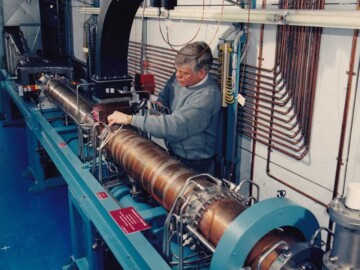
Photo source-AECL.

Photo source-The Society.



Three years later, on 03 August 2001 AECL announced the sale of its IMPELA Electron Accelerator technology to Iotron Industries Canada Inc., who had purchased the first commercial I-10-50.
Photo source-AECL.

Photo source-AECL.

In the final set of irradiations done with PHELA , the accelerator beam was used to do short-pulse, transient heating of reactor fuel samples (both fresh and irradiated) to allow the measurement of the thermal diffusivity of fuel at high temperatures as a function of burn-up. Making adjustments on the beamline shown in the photo are A. Davidson and I. McIntyre. Photo source-AECL.
All industrial accelerator programs ay CRNL were terminated with the closure of the Accelerator Physics Branch on 30 June 1996 due to financial constraints placed on AECL.
Whiteshell Laboratories
By the late 1950s Chalk River was considered to be approaching the maximum size for efficient operation. In 1959 the Canadian Government announced a decision to build a new laboratory in Manitoba and the Whiteshell laboratories were constructed with the main research effort based on n organic reactor WR-1, which went critical in 1965. This section covers only the early history of the Whiteshell site.




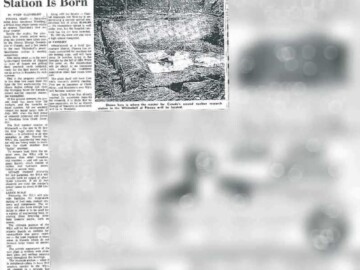





Power Projects
In 1958 a new power reactors division of AECL, known as Power Projects, was announced. This new entity would be located at Sheridan Park, Ontario and went on to play a major role in the design and development on CANDU power reactors. Over the years structural changes in the organization of AECL took place and at one point this division became a standalone company which was sold to private industry. This section covers only the early history.


Photo source – AECL.


Photo source and caption- AECL Review, May 1964.

Photo source – AECL Review, September 1964.

Photo source – AECL Review, September 1964.


Photo source - AECL

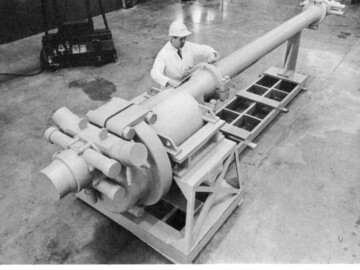
Photo and caption source – AECL Review, March 1967.

Photo and caption source- AECL Review, March 1967.

Photo and caption source – AECL Review, May 1967.
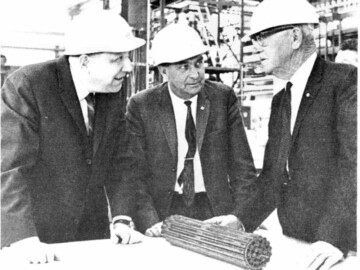
Photo and caption source – AECL Review, May 1967.

Photo and caption source – AECL Review, September 1968.

Photo and caption source – AECL Review, November 1970.

Photo source - the Society.
Commercial Products Division
The Commercial Products Division of AECL came into being in 1952. Originally part of Eldorado Mining and Refining Limited, the division was established to promote and market isotope sales (primarily Co-60) and cancer therapy units. It eventually became a standalone company and was sold to private industry. This section covers only the early history of the company and its products.

Photo source and caption – AECL Review, March 1977.


Photo and description source – AECL Review, April 1968.

Photo source – AECL Review, April 1968.

Photo source and caption – AECL Review, August 1967.

Photo source – AECL Review, April 1968.

Photo source and caption– AECL Review, March 1977

Photo source – AECL.

Photo source and caption– AECL Review, March 1977.


Photo source-AECL.

Photo source – AECL Review, March 1982.

Photo and caption information – CRNL Chalk Talk, December 1982.

Photo and caption – North Renfrew Times, 25 October 1961.


Photo and caption source – AECL Review, May 1964.


Photo source and caption– AECL Review, June 1968.

Photo source and caption– AECL Review, April 1970.

Photo source and caption– AECL Review, August 1973.

Photo source and caption– AECL Review, May 1967.

Photo source – AECL.




Photo source – AECL.
Other Research Reactors
The large research reactors at Chalk River, NRX and NRU, are well known for their contributions to the nuclear industry. Less well-known are three smaller research reactors, ZEEP, PTR and ZED-2. This document discusses their role in the evolution of the CANDU story.
By Rick Jones
The Other Research Reactors at Chalk River
The best known research reactors at Chalk River were first NRX and second NRU. These ran at high powers in order to provide high neutron fluxes, primarily for physics experiments and the investigation of materials properties under irradiation. However there were other research reactors designed and built for other purposes which ran at much lower power and neutron flux levels. These include, in chronological order of first criticality, ZEEP, PTR, and ZED-2.
ZEEP
ZEEP (Zero Energy Experimental Pile) was designed and built at the same time as the much larger project to design and build NRX was also underway. The main impetus seems to have been a desire to gain experience with the operation of a reactor which might be useful to the NRX project as well as to confirm the reactor physics properties (critical size etc.) of the core being designed for NRX.

Approval to construct ZEEP was given on October 10, 1944 and first criticality was achieved on September 5, 1945, just 11 months later! This was the first nuclear reactor to operate outside the United States.
The reactor vessel was a largely unshielded cylindrical tank with its axis vertical; open at the top to allow fuel rods to be suspended in the tank from beams. The reactor was made critical by pumping heavy water into the tank until a steady rise in neutron flux was measured indicating a supercritical core. Draining and pumping of heavy water was used control the flux level at the desired operating point which corresponded, because of the lack of shielding, to a power level of about 1 Watt.
The first fuel rods were natural uranium metal in the form of 19 cylindrical slugs 1.25 inches diameter by 6 inches long inserted in aluminum tubes.
An excellent description of the development of ZEEP and the programs of measurements undertaken up to its final shutdown on July 27, 1970 is given in: “ZEEP: The Little Reactor that Could” by R.E. Green and A. Okazaki, in the CNS Bulletin Vol 16 No 3, Autumn 1995.
PTR
PTR, or Pool Test Reactor, which first achieved criticality on November 29, 1957, was a very different reactor design from ZEEP and was aimed initially at one specific set of measurements. This was a light water natural convection cooled core located at the bottom of a light water pool about 6.5 m deep. The fuel used was so called MTR (Materials Test Reactor) fuel that consisted of plates of highly enriched uranium/aluminum alloy sandwiched in aluminum several of which were welded into an aluminum box to form a fuel element about 10 cm by 10 cm horizontally and 80 cm long in the vertical direction. Enough fuel elements to achieve a critical core (between 10 and 20?) were mounted in an aluminum core support plate.

The core region was surrounded on its vertical sides by a graphite neutron reflector in which were mounted ion chambers for flux monitoring. At the centre of the core was located a hydraulically driven sample changer or swing mechanism that was capable of interchanging two samples from a situation in which one was at the centre of the core and the other outside the core. The interchanges were made at a constant frequency the value of which could be varied according to the requirements of the measurement being made. If the samples are different in their nuclear properties this causes a modulation of the reactor flux level measured by one of the ion chambers located in the graphite reflector. Fourier analysis of the flux modulation to extract the amplitude of the fundamental frequency allows the relative neutron absorption or production properties of the samples to be extracted. Thus if the properties of one of the samples is known, say its absorption cross section, then the value of the same property of the unknown sample can be inferred.
Although the MTR fuel used was designed to be operated at high ratings, PTR only ever had to be run at powers in the range 0 to 100W since this provided an adequate signal from the ion chamber. The amount of shielding provided by the light water pool may therefore seem excessive. However the shielding was required not because of the radiation generated by operating the reactor, but rather because of the high radioactivity of some of the samples investigated.
The main mission of PTR was to track the reactivity (the balance between neutron production and neutron absorption) change with irradiation in NRX of various samples of fissile material. This was of particular interest for the development of a potential natural uranium fuelled heavy water moderated power reactor since it defines the amount of energy that can be extracted from the fuel before it must be replaced; a very important factor in establishing the economic viability of such a reactor. These measurements could in principal have been made in ZEEP, but the lack of sufficient shielding precluded them in practice. Various samples, including natural uranium metal, U235-Al alloy, and Pu-Al alloy, were studied making important contributions to understanding the potential viability of natural uranium heavy water reactors.
In later years PTR was used to establish the neutron absorption properties of samples of aluminum alloys proposed for use in NRU, both for fuel manufacture and use in structural components. It was also used as a neutron source for calibration of self powered neutron detectors destined for use in power reactors all over the world.
ZED-2
General Background
First criticality occurred in September 1960. ZED-2 is perhaps not very well known in the Canadian Nuclear Industry, certainly not as well known as the various CANDU power reactors or the research reactors NRU and NRX. Part of the reason for this I suspect is that when casually judging the importance of reactors the first parameters that spring to mind are power generated (for power reactors) or neutron flux (for research reactors), bigger being “better” in both cases. By these standards ZED-2 does indeed appear puny: the maximum allowed power is 200W and the corresponding flux about 108 to 109 neutrons cm-2 s-1, both numbers being about a factor of 500,000 smaller than the corresponding values for NRU.
ZED-2 is a descendant of famous progenitors: starting with Enrico Fermi’s first critical pile of graphite and uranium (created at the University of Chicago in 1942) through Canada’s ZEEP (first reactor to go critical outside the USA) that went critical in 1945. These early critical facilities were first about proof of principal that a self sustaining nuclear chain reaction could be established and controlled in a reasonable sized facility and second, in the longer term, developing understanding of the underlying reactor physics and the development of theories and methods to accurately predict the important properties of critical assemblies generally.
One of the first measurements of interest is of the size that a given “lattice” of fuel and moderator must be to achieve criticality. This came to be embodied in a reactor physics parameter called the critical buckling, which can be derived from the measured global flux distribution in a critical lattice.
In the early years of the Canadian program to develop what has become the CANDU power reactor system ZEEP proved large enough to investigate the lattices of 7-element and 19-element UO2 fuel in a single 3” pressure tube, although including a calandria tube such as were used in the NPD and Douglas Point reactors proved impossible. This, combined with the realisation that to develop an economically viable and competitive power reactor system a larger diameter fuel bundle in a correspondingly larger channel would be required, lead to the design and development of a larger ZEEP that came to be called ZED-2.
Description of ZED-2

This vertical section of ZED-2 shows the facilities main features, with homo-technicus in the control room to give an idea of the scale.
The cylindrical tank or calandria in which the lattice is assembled is 3.3 m in diameter and 3.3 m deep. It is surrounded by a graphite reflector to reduce neutron leakage.
The fuel assemblies (typically simulations of CANDU channels five bundles long) are hung from stainless steel beams to form the lattice of interest. The beams are movable by a hydraulic system to facilitate rapid changes to the lattice pitch.
Heavy water is stored in three dump tanks in the basement from where it can be pumped at carefully controlled rates into the tank. The reactor is controlled by adding D2O by pumping and removing by draining (leakage control)
Heating and cooling systems are available to vary the temperature of the heavy water before pumping it into the tank.
Emergency shut down is achieved by opening three large flap valves to rapidly dump the moderator back into the basement tanks. Trips (flux level and rate of change) are derived from neutron detectors located in the bottom graphite reflector.
Rolling shields on the top allow access through hatches in a rotating lid. The lid can be removed for major core modifications and is required to minimise heavy water vapour loss and downgrading by ingress of light water from the air.
Measurements made in ZED-2.
This review of some of the experiments performed in ZED-2 during its life to date is not an exhaustive, but hopefully will give an idea of what has been done and how this is related to the development of reactor physics in Canada and of the CANDU power reactor. Two main types of measurement are made: firstly reactivity measurements in terms of change in critical size (critical heavy water depth or buckling) corresponding to some change in the core, and secondly detailed reaction rate distribution measurements (fission rates, capture rates) in a single cell (fuel bundle and associated moderator PT and CT). The results obtained were used in the early days to tune the variable parameters in the computer codes used to calculate lattice properties (POOF, POWDERPUFS). These early codes were essentially recipes, based on good understanding of the physics involved, that calculated the homogenized cross-sections and other parameters required for the full core modelling codes based on neutron diffusion theory.
The first Decade, the 1960s
During this period the first measurements were made with a core of 28-element natural UO2 bundles in 4” Al channels (by Ken Serdula). These included measurements of critical size (buckling) as a function of lattice pitch with three coolants in the channel: heavy water, air, and HB40 organic. The temperature of the lattice was at room temperature throughout.
Measurements were also made in these cores of the impact of various shut off rod designs that were being proposed for use in CANDU reactors (By Al Okazaki)
Also of significance were early developments of techniques for measuring properties of a fuel lattice when only a few rods of that fuel were available. This so called substitution method was applied to studies of four natural uranium fuel types in a 37 element geometry. These were UO2, Uranium Carbide, Uranium Silicide, and Uranium metal. An important reason for interest in such techniques was of course to minimise costs: only 35 bundles of each fuel type were needed compared to about 275 for a full core. These methods of measurement and analysis were pioneered by Al Okazaki and Don Craig.
The Early 1970s
A major measurement was made on fuel from the first charge of 37-element bundles built for the Bruce reactors. Buckling measurements were made in various shaped cores of the square lattice used in the power reactors, both cooled with D2O and by air. The coolant void reactivity, an important parameter in LOCA analysis was important. Problems with these measurements arose because of B contamination of the Al tubes purchased to simulate the Zr PT and CT of the power reactor lattice.
All measurements so far had been made at room temperature (and with fresh fuel) except for some variation of the temperature of the D2O moderator At this time a method to heat the water coolant and fuel in 7 specially built rods to up to 300C was developed so that the impact of temperature changes on reactivity could be measured; again making use of the few rod substitution technique.
The late 70s and early 80s
This was the time of advanced fuel cycles when it was believed that the future of CANDU lay in the burning of recycled Pu or potentially U233 in a self sustaining thorium cycle. This belief was based on twin estimates of the amount of uranium available to mine and of the rate at which installed nuclear capacity would be added to meet the world’s requirements.
ZED-2 measurements were made on (Pu,U)O2 fuel manufactured in Italy, (Pu,Th)O2 fuel manufactured in an alpha-active glove box fuel manufacturing facility at CRL, and on (U233,Th)O2 fuel made in the same facility. Again to keep costs reasonable only a few rods of each fuel type were produced.
Unfortunately these measurements were barely completed before it was realised that if indeed CANDU’s future involved advanced fuel cycles it would be a significantly more distant future than had once been thought.
Late 80’s and 90s
At this point the future of ZED-2 seemed to be in considerable doubt, but happily (for those who worked in ZED-2) The CANDU utilities, the regulator and the coolant void reactivity came to the rescue. Questions were being raised about the values of reactivity being generated by the codes used in LOCA analysis which still derived fundamentaly from a recipe type code (POWDERPUFS) that had been tuned to ZED-2 measurements on fresh fuel and at room temperature.
In collaboration with reactor physicists from the utilities and Sheridan Park an extensive program to provide code validation data for calculation of CVR was planned and executed under the umbrella of the CANDU Owners Group (COG). This program included the manufacture of 35 bundles of 37-element fuel at CRL whose composition attempted to represent that of mid burnup CANDU fuel for CVR measurements by the substitution method. In addition a major effort went into validation of the substitution method for CVR measurement and the capabilities of the ZED-2 hot sites were extended so that CO2 could be used as the heat transfer medium in the coolant space thus allowing CVR to be measured for a channel temperature range up to 300C. The results of this program were in part responsible for the acceptance by the industry that it was time to give up the use of recipe cell codes and adopt a more modern code (WIMS-AECL was chosen) based on a fuller solution of the neutron transport equation.
The 00s
In 2005 a set of measurements had been completed on so called Low Void Reactivity Fuel that used a 43-element fuel bundle (CANFLEX) with neutron absorbers in the central element and slight enrichment in the rest of the bundle. This fuel was destined for use in the Bruce Reactors, but this author does not know if it was ever actually adopted.
Following that, emphasis was shifted to measurements to support the development of the ACR (Advanced CANDU Reactor) involving development of an extensive program to provide validation data for the codes which were to be used.
Some Comments on Operation
The operation of ZED-2 (and ZEEP and PTR) was for many years the responsibility of a research division within AECL rather than of the Operations Division, which was responsible for the NRX and NRU reactors. For most of its life the Senior Reactor Physicist reporting to the Director of the appropriate Research Division was responsible for safe operation and the operating staff consisted of technicians from the same division. Good relations with the Operating Divisions ensured that assistance with such matters as calibration and maintenance of safety systems was readily available. Safe operation of facilities like ZED-2 that are of necessity flexible in terms of the cores that can be installed, have limited shielding designed to provide protection during normal operation at low licensed power, and allow for easy access of staff to the core region, certainly provides many challenges. Pre Chernobyl such reactors had been responsible for the most damage to staff from radiation of any reactor type. Happily the safety record in ZED-2 has been excellent, perhaps in part due to the fact that the staff were always aware that if anyone was going to be injured it was them, there being very little possibility of damage to people outside the facility. In recent years the management structure and the documentation governing operation have been expanded to align more closely with those of other larger reactor facilities.

